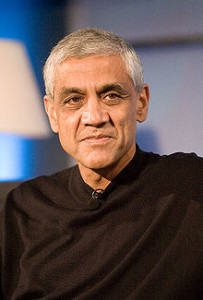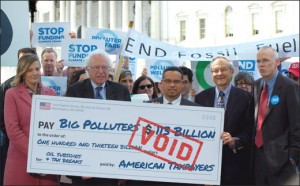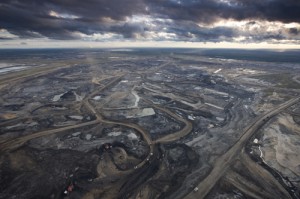Open letter to 60 Minutes and CBS By Vinod Khosla
On January 5, 2014, CBS’ 60 Minutes aired a segment titled, “The Cleantech Crash” that grossly misrepresented the state of the sustainable energy industry.
At Khosla Ventures, we are focused on finding real solutions for energy independence, rather than just pontificating. The pontificators at 60 Minutes, with their agenda-driven bastardization of news reporting, failed to do the most elementary fact checking and source qualification, as was the case with your Benghazi reporting. No wonder one major media outlet wrote that you have been “widely criticized for leaving out crucial information about the state of the clean tech sector.” Is this the new CBS standard?
The errors in your story are numerous.
Fact: I have not invested over a billion dollars of my own money into cleantech. It is substantially less, and a simple query to us would have corrected this error. We manage a balanced portfolio, and it has not “crashed” nor is it “dead”. In fact, our returns are significantly above the venture capital average.
would have corrected this error. We manage a balanced portfolio, and it has not “crashed” nor is it “dead”. In fact, our returns are significantly above the venture capital average.
Fact: Contrary to your assertion, the U.S. Department of Energy (DOE) Loan Guarantee Program has created 55,000 new cleantech jobs. [1]
Fact: The DOE loan program, despite your implications, has a 97% success rate. [2] The former program head, Jonathan Silver, expects it to make money, not be a subsidy.
Fact: There is $51 billion remaining in DOE loan money.[3] The amounts in the CBS report are far from “spent” or allocated. You seem to want to cite big numbers, whether they are true or not!
Fact: A substantial portion of DOE loans is allocated to nuclear energy[4], not just cleantech segments like biofuels, solar or wind, a fact conveniently left out despite your being aware of it.
Fact: The U.S. spent $502 billion subsidizing fossil fuels in 2011. This is the result of directly lowered prices, tax breaks and failing to properly price carbon’s negative externalities.[5] You ignored the fact that energy is far from being a level playing field. Many other subsidies are hard to account for like MLP partnerships, accelerated depreciation and below-market royalties that are never categorized as fossil fuel subsidies that disadvantage cleantech.
Fact: According to a senior U.S. Navy official, last year alone, $80 billion of taxpayer money was spent patrolling just the oil sea-lanes in the Arabian Gulf. There are many sea-lanes we patrol. Globally and over time, the U.S. has spent $7 trillion patrolling them.[6] Such “protection spending” of U.S. taxpayer dollars for the oil industry is a much larger subsidy than any amount spent to support the cleantech industry, a fact CBS chose to overlook despite my statements on camera. This may be the largest U.S. subsidy in history, and it was purposely ignored because it is inconsistent with your agenda. Cleantech subsidies are a miniscule fraction of one-percent of these amounts. Read the full article.
Fukushima Fallout
Japan is facing its biggest-ever backlash towards nuclear power in the aftermath of the March 11, 2011, tsunami triggered by a 9.0 magnitude earthquake that wiped out not just entire towns and villages, but also destroyed a nuclear power plant.
See Michio Kaku Professor of Theoretical Physics at the City College of New York interview with Democracy Now’s Amy Goodman discussing the tragic events of Fukushima.
Suntech’s Andrew Beebe On US Tariffs
 Suntech Power Holdings Co., Ltd. (NYSE: STP), the world’s largest producer of solar panels, offers the following statement regarding the U.S. Department of Commerce’s preliminary decision to impose antidumping duties (AD) of 31.22% on Suntech’s crystalline silicon photovoltaic cells imported from China.
Suntech Power Holdings Co., Ltd. (NYSE: STP), the world’s largest producer of solar panels, offers the following statement regarding the U.S. Department of Commerce’s preliminary decision to impose antidumping duties (AD) of 31.22% on Suntech’s crystalline silicon photovoltaic cells imported from China.
“These duties do not reflect the reality of a highly-competitive global solar industry. Suntech has consistently maintained a positive gross margin as revenues are higher than our cost of production. We will work closely with the Department of Commerce prior to their final decision to demonstrate why these duties are not justified by fact,” said Andrew Beebe, Suntech’s Chief Commercial Officer.
“As a global company with global supply chains and manufacturing facilities in three countries, including the United States, we are providing our U.S. customers with hundreds of megawatts of quality solar products that are not subject to these tariffs,” continued Mr. Beebe.
“Despite these harmful trade barriers, we hope that the U.S., China and all countries will engage in constructive dialogue to avert a deepening solar trade war. Suntech opposes trade barriers at any point in the global solar supply chain. All leading companies in the global solar industry want to see a trade war averted. We need more competition and innovation, not litigation,” continued Mr. Beebe.
End Polluter Welfare Invest In Solar
 “I am proud to be here today with Congressman Ellison, with my good friend and fellow Vermonter Bill McKibben, with Brent Blackwelder from Friends of the Earth and Ryan Alexander from Taxpayers for Common Sense.
“I am proud to be here today with Congressman Ellison, with my good friend and fellow Vermonter Bill McKibben, with Brent Blackwelder from Friends of the Earth and Ryan Alexander from Taxpayers for Common Sense.
We are here today not just to announce new legislation, but to send a message – and that message is that it is time to end the absurdity of taxpayers providing massive subsidies to hugely profitable fossil fuel corporations. In these difficult economic times, it is imperative that we support the taxpayers of this country and not the fossil fuel industry – one of the most powerful special interests in the world.”
Our federal government is set to give away over $110 billion in taxpayer dollars to the oil, gas, and coal industries over the next 10 years. That is totally absurd.
When we have a $15.6 trillion national debt, we cannot afford it. When the five largest oil companies have made over $1 trillion in profits in the last decade, they don’t need it. When some of these same polluters have, in a given year, paid zero in federal income taxes and actually received IRS rebate checks worth millions, they don’t deserve it. When fossil fuels are the number one source of human-caused greenhouse gas emissions, creating a planetary crisis of global warming that is already causing devastating extreme weather disturbances, we can’t ignore it.
As people throughout our country are demanding that we invest in energy efficiency and sustainable energy, and when Congress has instead allowed key sustainable energy incentives to expire even as Big Oil reaps billions in subsidies, it is time to change our national energy priorities. So today, Congressman Ellison and I are introducing the End Polluter Welfare Act in the House and the Senate. Read the complete article: End Polluter Welfare
Remarks by the President on American Energy
Nashua Community College Nashua, New Hampshire
Text -
THE PRESIDENT:
Hello, Nashua! (Applause.) It is good to be back in New Hampshire! (Applause.)
Thank you, Mike, for that wonderful introduction and for your service to our country. I want to thank the president of Nashua Community College, Lucille Jordan, for hosting us here today. Give Lucille a big round of applause. (Applause.) We’ve got Professor Paul Wunderlich, who gave me a great tour. Where’s Paul? Where is he? He’s got a beard — you can see him. (Laughter.) There he is. And I want to thank your Mayor, Donnalee Lozeau, for joining us here today. (Applause.) Where’s Donnalee? Right over there — there. Right in there.
AUDIENCE MEMBER: We love you!
THE PRESIDENT:
I love you back. It is good to be back in New Hampshire.
AUDIENCE MEMBER: (Inaudible) 911! 911! Somebody’s down!
THE PRESIDENT:
Okay, we’ll be all right. They probably were just standing too long. Just give them a little space. Where’s our EMS folks? They’ll be okay. Just give him a little space. This happens sometimes. You guys been here a while after the magging?
AUDIENCE: Yes.
THE PRESIDENT:
Well, no, you have to eat ahead of time. (Laughter.) Keep your blood sugar high. We got somebody over there? Jordan, right in the middle. There we go. Here’s our guy. Make a little room, everybody. All right, let’s make sure everybody is okay. You all right? All good? Okay. I think you’re going to be all right. Okay. (Applause.) So remember, eat before you come to a presidential event. (Laughter.)
Now, I am from Chicago, so you know a little snow was not going to keep me away — (applause) — which is why I can relate to New Hampshireites, because this is just like a dusting. (Laughter.) What’s the big deal? There’s no big deal. When Air Force One landed there were like 50 people waiting to shake my hand — they got icicles on their eyebrows. (Laughter.) I was like, hey, great weather. (Laughter.) So I want to thank all of you for making the trek out here. I really appreciate it.
I just had a chance to look at some of the cutting-edge work that’s being done here at the auto shop. Earlier this week, I gave a speech to American autoworkers where I said that one reason this country has an auto industry today is because we’re not just building cars again — (applause) — we’re building cars that use less oil, cars that go further on a gallon of gas. And in part, that’s because of what’s happening in places like this community college. It’s because of so many of you. I don’t need to tell you why fuel efficiency is so important, especially right now. Most of you filled up your gas tanks in the last week or two, am I right? - Full Text of the Speech: Remarks by the President on American Energy
Big Carbon’s Sock Puppets Declare War on America and the Planet
By Robert F. Kennedy, Jr.
 It’s now become de rigueur among the radical right wing rhetoricians to characterize any government support of America’s green energy sector as wasteful, fruitless, and scandalous. They greeted with glee the collapse of the government supported solar company, Solyndra, America’s first major casualty in our race with China to dominate the “new energy” economy. With Solyndra dying on the battlefield — its marketplace choking on inexpensive Chinese solar panels — the right wing’s response was to hoist the white flag and declare defeat in the war for global cleantech leadership. That brand of “Can’t Do” cowardice is a boon to the carbon and nuclear power incumbents who fund so much of the right wing’s activities — but it’s bad for America.
It’s now become de rigueur among the radical right wing rhetoricians to characterize any government support of America’s green energy sector as wasteful, fruitless, and scandalous. They greeted with glee the collapse of the government supported solar company, Solyndra, America’s first major casualty in our race with China to dominate the “new energy” economy. With Solyndra dying on the battlefield — its marketplace choking on inexpensive Chinese solar panels — the right wing’s response was to hoist the white flag and declare defeat in the war for global cleantech leadership. That brand of “Can’t Do” cowardice is a boon to the carbon and nuclear power incumbents who fund so much of the right wing’s activities — but it’s bad for America.
Leveraging the aberrant Solyndra bankruptcy, these groups have launched an orchestrated series of attacks against the renewables sector by trying to discredit other companies, even those that are driving America forward with innovative solutions that actually do compete on a global basis. For example, last month, Fox News ran a story insinuating that SunPower received a loan guarantee for its Central Valley Solar Ranch project because of its political connections Congressman George Miller. The story also suggested that SunPower was struggling financially and posed another risk to taxpayers — a la Solyndra. The truth is that SunPower is one of America’s strongest solar manufacturing companies and Mr. Miller had nothing to do with the company receiving a loan guarantee for its Central Valley Solar Ranch Project. To Fox News and other right wing media sources, the facts meant very little. Their intent is only to suggest wrong-doing in an attempt to undermine the Obama Administration and its clean energy goals. Source: Huffington Post – Read the full article :Big Carbon’s Sock Puppets Declare War on America and the Planet
California’s Solar Program a Big Success
First-Ever Analysis of California’s Solar Incentive Program Documents Much Progress, Predicts Bright Future
 The Environment California Research & Policy Center released a new report documenting that California’s innovative Million Solar Roofs Initiative, halfway through its legislatively mandated timeline, is on pace to meet its goal of installing 3 gigawatts of solar capacity by 2016, is helping to reduce the cost of solar energy, and is creating thousands of jobs throughout the state. These findings come just as California hits the milestone of installing more than 1 gigawatt of rooftop solar power across the state—a milestone that only five other countries in the world have reached.
The Environment California Research & Policy Center released a new report documenting that California’s innovative Million Solar Roofs Initiative, halfway through its legislatively mandated timeline, is on pace to meet its goal of installing 3 gigawatts of solar capacity by 2016, is helping to reduce the cost of solar energy, and is creating thousands of jobs throughout the state. These findings come just as California hits the milestone of installing more than 1 gigawatt of rooftop solar power across the state—a milestone that only five other countries in the world have reached.
“California can become the Saudi Arabia of the sun if it continues to get behind big, successful solar programs,” said Michelle Kinman, Clean Energy Advocate with Environment California Research & Policy Center and co-author of the report, Building a Brighter Future: California’s Progress Toward a Million Solar Roofs. “All signs point to a bright future for solar power in California, meaning cleaner air, cleaner energy, and more jobs.”
The 2006 Million Solar Roofs Bill (SB 1 – Murray) was historic in both scope and scale, representing the first unified state effort to turn solar power into a commonplace and affordable energy resource for average citizens. The law established a 10-year, statewide interagency effort, now called the Go Solar California campaign, which includes programs that fund solar projects on homes, commercial businesses, farms, and government and non-profit buildings.
Key findings of the report include:
• Even in a weak economy, California’s solar market has been expanding exponentially by about 40 percent per year. If the market continues growing at a rate of 25 percent per year, the state will achieve the 3,000 MW goal by the end of 2016.
• Five years in, the Million Solar Roofs Initiative is one-quarter of the way toward its goal of installing 3,000 MW of distributed solar energy systems by the end of 2016 – putting the program on a pace to meet the overall goal on schedule. Since the first solar panels under the Million Solar Roofs Initiative were connected to the grid in 2007, California has installed nearly 800 MW of solar photovoltaic power – the equivalent of powering 600,000 single family homes.
• California is home to about 20 percent of all solar power companies in the United States, with more than 3,500 firms. These firms employ more than 25,000 people. The industry has roughly doubled in size since 2007, and is a bright spot in our overall economy.
• California has tremendous untapped solar energy potential. The National Renewable Energy Laboratory estimates that the state could host more than 80,000 MW of rooftop solar capacity – which could generate more than a third as much electricity as California uses in a year.
• Other countries are demonstrating that it is possible to rapidly expand the solar market and achieve ambitious goals. Germany, for example, has already reached 17,000 MW of solar capacity – nearly 17 times California’s current total – through consistent and strong public policy support. Read the full article: California’s Solar Program a Big Success
To Create Jobs, America Can Learn from China – According to Economic Trends Expert, Dr. Stephen Leeb
 “America needs to learn from the example for future growth and long-term sustainability being set by China, and build the infrastructure and invest in the education and development of talent in growth industries, such as renewable energy and electronics, to achieve long-term growth and the continuation of the whole American experience,” according to Dr. Stephen Leeb, a recognized authority on finance, investing and economic trends. Leeb spoke with Peter Clayton, producer/host of TotalPicture Radio, a popular career and leadership development podcast.
“America needs to learn from the example for future growth and long-term sustainability being set by China, and build the infrastructure and invest in the education and development of talent in growth industries, such as renewable energy and electronics, to achieve long-term growth and the continuation of the whole American experience,” according to Dr. Stephen Leeb, a recognized authority on finance, investing and economic trends. Leeb spoke with Peter Clayton, producer/host of TotalPicture Radio, a popular career and leadership development podcast.
Realizing the tremendous career and growth opportunities in “green” industries and technology, Clayton regularly features experts in the field on his program.
However, the picture Dr. Leeb paints in his interview is troubling. China is gaining ground as a superpower and attaining competitive advantage over other developed countries, especially the United States, by using its profits to globally invest in and control mineral commodities such as coal, oil, zinc, silver, and gold. In his latest book Red Alert: How China’s Growing Prosperity Threatens the American Way of Life, Leeb argues that access to rare earth resources will determine the standard of living for future generations.
Leeb discusses how “U.S. officials and politicians engage in short-term myopic planning, endless legal maneuvering, scandals, and wartime investing that are crippling America’s economic viability.” Contrast this with China’s government, led by politicians with backgrounds in hard sciences. “China is spending enormous amounts of money planning for, and analyzing, the long-term consequences of global warming,” Leeb asserts. “The Chinese, I don’t think, hate Americans, by no means, but the Chinese are all for China. They would like to come off as the heroes in the environmental revolution.”
“There’s a war going on out there in the world between the two most important economic powers: the United States and China. We don’t know we’re fighting a war. We are,” said Leeb. “Our country needs to start looking forward to our future and how we can win this war and continue to prosper. However, it’s going to be virtually impossible to build out a new renewable energy society or create new energies, whether they call them renewable or not, without having access to rare earth. Right now, we don’t.”
As an example of the “war” with China, Leeb pointed to the Solyndra scandal. “Yes, there were bad people that were running Solyndra. The real issue here is that the most honest, best businessmen in the world would have run into trouble, too – almost insurmountable trouble – because, in the end, there’s really no U.S. solar company that can compete effectively with Chinese solar companies.”
Leeb views China’s accumulation of rare earth assets as proof of the country’s growing strength. “China almost has a hammerlock on two premier renewable energy markets – wind and solar,” said Leeb. “Their control and refining of the heavy rare earth elements, which are essential for building magnets that go into wind turbines, hybrid automobiles and military equipment, clearly demonstrates China’s ever-increasing lead in the global environmental revolution.”
“You know, the benefit of this is just as in China: if we do wake up to this, we will create a number of very big growth industries in this country – huge growth industries with great jobs,” Leeb concluded.
Green Economy Losing Steam?! I’m Seeing Red!
 by Carol McClelland, PhD: On August 19, 2011 the New York Times published a story entitled, “Number of Green Jobs Fails to Live Up to Promises.” The bottom line of this article was that the government’s attempts to create jobs through stimulus have failed. They use the microcosm of a green jobs training program and a solar company in San Jose as Exhibit A and B for the failures of the green economy.
by Carol McClelland, PhD: On August 19, 2011 the New York Times published a story entitled, “Number of Green Jobs Fails to Live Up to Promises.” The bottom line of this article was that the government’s attempts to create jobs through stimulus have failed. They use the microcosm of a green jobs training program and a solar company in San Jose as Exhibit A and B for the failures of the green economy.
When I first read this article I was seeing red.
Red flags that is!
Although I’m not a statistician or an economist, I’ve been following the ebb and flow of the emerging economy long enough to see past the headline. To know that the descriptions of the examples are so skewed that’s they can’t be used as the basis for a broad brush statement about the green economy. In other words, the bottom line conclusions made in this article are, in a word, bogus.
I thought it would be helpful for you to see how I approach an article like this to assess it and come to my own conclusion about what’s being reported.
Start by checking out the original source referenced in the article. Read the full article: Green Economy Losing Steam
Keystone Pipeline, Tar Sands Oil, and Climate Change Are Not in Our National Interest
Peter Lehner, Executive Director, Natural Resources Defense Council New York City
 Over the next few months, the State Department will examine whether the proposed Keystone XL pipeline running from the Alberta tar sands oil fields to the Texas Gulf Coast is in America’s national interest.
Over the next few months, the State Department will examine whether the proposed Keystone XL pipeline running from the Alberta tar sands oil fields to the Texas Gulf Coast is in America’s national interest.
To answer that question, you have to decide what kind of future you want for our country.
Do you want America to create cars that can go twice as far on a gallon of gas, employ 150,000 workers to build, and cut our oil use by more than 3 million barrels a day?
Or do you want America to remain addicted to fossil fuels and to accelerate the climate change will worsen storms, increase disease, and flood coastlines? Do you want the U.S. to become the middleman to enrich foreign oil companies?
America isn’t accustomed to being in the passenger seat, and there is no reason we should start handing over the controls to Canadian oil companies now.
Because that’s what the Keystone XL pipeline would entail. It isn’t designed to benefit America; it is designed to benefit tar sands operators.
Oil companies acknowledge they plan to use the pipeline to export their product. Operators in Alberta’s tar sand fields often refer to themselves as landlocked. That wouldn’t be a problem is your major market were the enormous land mass to the south. But if you want to export to Asia and if British Columbia hasn’t let you build a pipeline to its ports because of safety concerns, then you pursue a pipeline to the closest deepwater port: Port Arthur, Texas.
Once the tar sands oil hits the transportation network in Port Arthur, it can go anywhere in the world. TransCanada, the company behind the Keystone XL pipeline, told regulators that 90 percent of the pipeline’s initial capacity would go to six shippers. Those shippers include Shell, Total, and Valero—the largest fuel exporter in the United States. Their statements to investors and regulators leave no doubt they plan to use tar sands oil to produce diesel fuel for export.
The Keystone XL’s tar sands oil will be exported, because America doesn’t need it. Our nation is already a net exporter of finished petroleum products. That’s why a good deal of Keystone’s capacity will end up on the international market. Read the complete article: Keystone Pipeline, Tar Sands Oil, and Climate Change Are Not in Our National Interest

